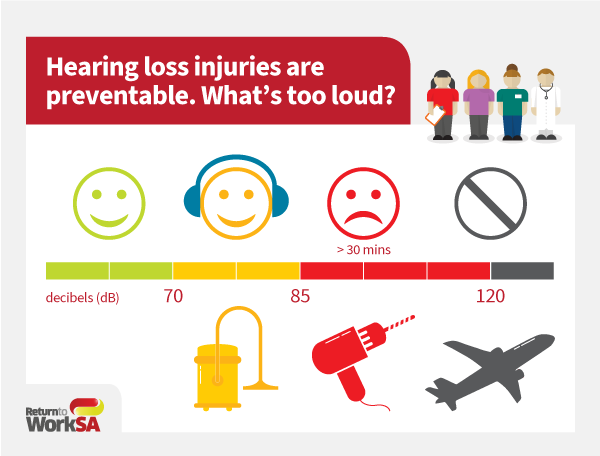An increase in claims for noise induced hearing loss (a larger increase than any other claim type) has highlighted the growing impact that noisy tasks and working environments are having on workers’ hearing. Employers, health and safety representatives and workers all have a crucial role to play in monitoring, managing and helping to prevent noise induced hearing loss and other noise/ vibration related injuries in the workplace.
What causes noise induced hearing loss?
Noise induced hearing loss can occur from ongoing exposure to high noise levels. The louder the noise and/ or the more exposure a worker has to it, the greater the hearing loss may be. It can also occur if someone is exposed to very intense or explosive sounds. (SafeWork SA)

TABLE: Common noise sources and their typical sound levels (Managing noise and preventing hearing loss at work: Code of practice– external site)
| Typical sound level in dB(A) | Sound source |
|---|---|
| 140 | Jet engine at 30m |
| 130 | Rivet hammer (pain can be felt at this threshold) |
| 120 | Rock drill |
| 110 | Chain saw |
| 100 | Sheet-metal workshop |
| 90 | Lawn mower |
| 85 | Front-end loader |
| 80 | Kerbside heavy traffic Lathe |
| 70 | Loud conversation |
| 60 | Normal conversation |
| 40 | Quiet radio music |
| 30 | Whispering |
| 0 | Hearing threshold |
What are the other implications of noise exposure in the workplace?
Noise may damage your hearing and cause other health effects such as:
- stress
- hypersensitivity to noise
- increased blood pressure
- increased heart rate.
Noise can also interfere with performance, communication and reduce reaction times, which could lead to accidents.
How do employers know if their workplace noise levels are high-risk?
Risk reduction starts with the assessment of noise levels– external site in your work environment. A noise assessment should be done by a competent person in accordance with AS/NZS 1269.1:2005 Occupational noise management – Measurement and assessment of noise emission and exposure. The more complex the situation, the more knowledgeable and experienced the person should be.
The assessed noise levels will help determine which control measures are appropriate for your business. Where possible, eliminate or reduce the noise so that it falls within safe levels. If noise reduction is not possible then hearing protection will be required. Use of hearing protection must be coupled with training and enforcement to be effective, however, provision of hearing protection as a stand-alone measure may not guarantee safe levels of exposure.
What can employers do to reduce the risk of noise induced hearing loss?
Some practical steps that employers can take to reduce the risk of noise induced hearing loss are:
- Limit the time your employees spend in noisy places and ensure they take regular breaks in quieter areas.
- Provide personal protective equipment (PPE) such as earmuffs or earplugs.
- Make your workplace quieter by using sound dampeners or noise barriers.
- Be aware that exposure to solvents or toxins and some drugs can increase the risk of hearing loss.
You can find out more about managing your workplace noise risk by looking at the information provided by SafeWork SA: Noise and vibration | SafeWork SA– external site
How is ReturnToWorkSA addressing the risk of noise induced hearing loss?
ReturnToWorkSA has partnered with SafeWork SA to visit workplaces throughout South Australia to ensure noise risks are effectively managed. To prepare for these visits, we ask that your workplace assesses the effectiveness of your current approach and makes any required improvements by using the resources linked below. If you require support, you can contact the SafeWork SA WHS Advisory Service– external site.
Additional resources
